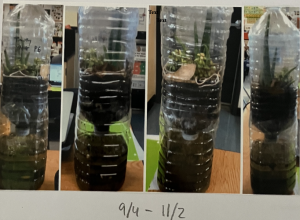How important are material tools in the production or acquisition of knowledge?
Theme: Knowledge and Technology
By Norran Y. (11th Grade)
Word count: 661
Object #1: (My screwdriver set – front and back)
The object chosen for this exhibition is my precision screwdriver set meant for taking apart electronics. It enables me to uncover and observe the internals of any electronics’ structure. Consisting of 124 pieces and including 98 screwdriver tips of all necessary types and sizes, this technology can deal with any teardown with maximum precision.
My screwdriver set is justified for inclusion in the exhibition because it demonstrates that material tools can help one acquire a posteriori knowledge by being able to help justify them through empirically verifiable statements. (1) As Schopenhauer stated, a person obtaining knowledge “a posteriori through experience, finds to his that he is not free [in forming conclusions], but liable to necessities” such as technology.
The primary procedure in acquiring any form of a posteriori knowledge is through observations, then forming a deductive or inductive (2) conclusion. However, “we tend to make hasty generalisations and jump to conclusions on the basis of insufficient evidence”. Therefore, the final step in successfully acquiring the knowledge would be to empirically justify the a posteriori claim. Furthermore, in the case of my laptop, I first realised that – through my sense of touch – most of the heat was concentrated in the chassis above my keyboard. Previous knowledge revealed that only the CPU of a computer produced heat via friction of electrons. Thus, making me induce that my laptop’s CPU – or any laptop CPU – is located under the part of the chassis giving off heat. As aforementioned, this claim lacked the final step of empirical justification. Upon tearing down my laptop using my screwdrivers, I found its location to be much further away from the previously observed coordinates; and in its place instead: an aluminum cold plate connected via a copper pipe to a heatsink above the CPU. Therefore, the technology of material tools are essential in acquiring a posteriori knowledge as they provide empirical justifications and conclusions when our senses are limited, avoiding the hasty generalisations.
Note 1: HZT4UE Textbook – Empiricism. “Chapter 5: The Sources of Knowledge” Essay. In Can the Senses Account for All Our Knowledge?, 378. https://drive.google.com/file/d/12Z-iNtyoXWN-VhMNkGaNqaNC5R1gzAL7/view.
Note 2: HZT4UE TOK Textbook. “5. Reason.” Essay. In How Reliable is Inductive Reasoning?, 121. https://drive.google.com/file/d/1BH_DL3-hu7aJSkoVAw_DbPEa72zP2FOK/view?pli=1.
Object 2: Static CPU cooler taken from my Chromebook
The object chosen for this exhibition is a simple CPU cooler, produced by ASUS, taken from my old Chromebook which I took apart a few months ago. This tool’s function is to help the CPU – essentially the computer’s brain – maintain low temperatures to stay functioning without overheating. Primarily composed of copper, it includes only (and simply) a heat pipe, heat sink, and aluminium cold plate; without any moving parts such as fans or liquid.
The cooler is justified for inclusion in this exhibition because it can prove the absence of material tools in producing a priori knowledge because of their strong association with empiricism. Additionally, Immanuel Kant defines “pure knowledge à priori as that with which no empirical element is mixed up”.
To produce a priori knowledge, one must logically reason and analyse concepts without sensory experience or empirical observations. Thus, my CPU cooler demonstrates the limitations in material tools being able to produce this knowledge because its design relies heavily on logical principles, such as thermodynamics. A priori knowledge is knowing that a cold object touching a warmer one will result in the warmer one becoming cold through the transfer of heat. The cooler can only verify this knowledge while not being able to produce it, as all tools are created to solve an issue. Hence, they are created a posteriori as the maker has to experience the issue beforehand. Additionally, this indicates that – throughout the ages – “in the midst of tool-making, man has achieved the capacity to adapt his environment to his need and impulse”. My cooler solves the problem of the CPU overheating and is created with the most simplistic of designs. The more complex a design is, the more a posteriori knowledge and empirical testing are required in the production of it; parallel to Occam’s razor theory. Therefore, my object proves that material tools – themselves being products of a posteriori knowledge – cannot help one produce a priori knowledge. Thus, not being as important in this sense.
Works Cited
HZT4UE TOK Textbook. “5. Reason.” Essay. In How Reliable is Inductive Reasoning?, 121. https://drive.google.com/file/d/1BH_DL3-hu7aJSkoVAw_DbPEa72zP2FOK/view?pli=1.
Morrey, Douglas. “Michel Houellebecq: Humanity and its Aftermath” Essay. In Three Science and Religion. Accessed Jan 4, 2025. https://academic.oup.com/liverpool-scholarship-online/book/43222/chapter/362947527.
HZT4UE Textbook – Empiricism. “Chapter 5: The Sources of Knowledge” Essay. In Can the Senses Account for All Our Knowledge?, 378. https://drive.google.com/file/d/12Z-iNtyoXWN-VhMNkGaNqaNC5R1gzAL7/view.
Velasquez, Manuel G. “Chapter 5: The Sources of Knowledge.” Essay. In Philosophy: A Text With Readings, 8th ed., 378–386. Belmont, CA: Wadsworth Pub. Co., 2002.
Woolman, Michael. Ways of Knowing: An Introduction to the Theory of Knowledge. Seconded. IBID Press, 2006.
Washburn, Sherwood L. “Tools and Human Evolution.” Scientific American 203, no. 3 (1960): 62–75. https://www.jstor.org/stable/24940615.
Kant, Immanuel. “The Critique of Pure Reason” Essay. In Of the difference between Pure and Empirical Knowledge. (1781). https://www.gutenberg.org/files/4280/4280-h/4280-h.htm#chap05.






